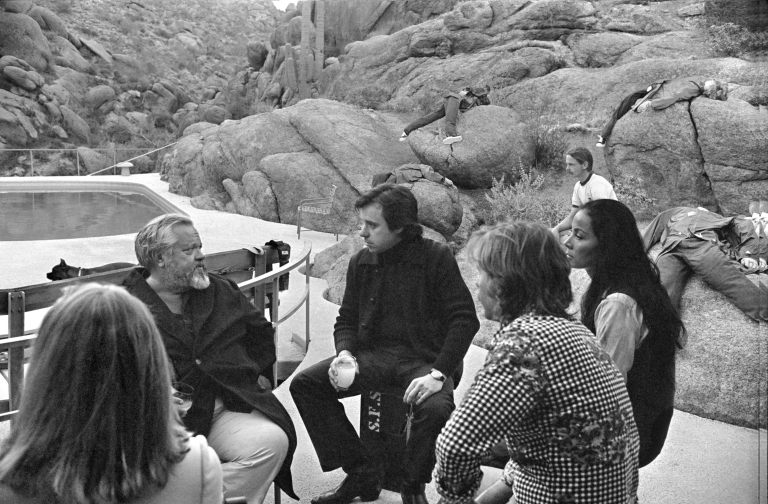“The Other Side of the Wind” is an echo chamber, a hall of mirrors and an irreverent saga jabbing at Hollywood, macho-ism, literary figures and European art cinema. A disorienting ordeal with cinematic Easter eggs scattered throughout, “The Other Side of the Wind” is Orson Welles’ final film 50 years in the making, posthumously released. Held back by financial, legal and political obstacles, production of the film began in 1970. The film tells the story of a famous director, played by John Huston, returning from exile to make an inventive final film, also called “The Other Side of the Wind.” It’s a film within a film, the frame-film shot in a realistic, “cinema verité” style and the film-within-the-film made in the style of a 1960s European art film.
In many ways incomplete and incoherent, Orson Welles’s last film is also his last laugh. Since Welles left behind this unfinished film when he died in 1985, it is hard to know exactly what he was doing in “The Other Side of the Wind,” but it is at least clear that it is unlike anything Welles released during his lifetime. This is no “Citizen Kane” — but its depravity is perhaps the perfect ending to the career of a director that began on such a high note yet was unable to secure funding for many of his later projects.
At a screening at the 2018 Telluride Film Festival, producer Peter Bogdanovich called the movie Orson Welles’ “dirty film.” It has been two months since I first saw the film in Telluride, and its depravity still haunts me. Welles reveals the dark side of Hollywood as well as of his own personality, exposing himself and his peers. What I witnessed was a shock, a displeasure and an utter nightmare — I left disgusted, angry and thoroughly disappointed not only for myself but also for Orson Welles, who I felt deserved a better final film.
But maybe that is exactly the point. Welles is being honest, and it leaves one wishing he hadn’t been. For two months, I’ve struggled to put into words how I felt about the film and have waited patiently for its release on Netflix, dreading my compulsion to return to it. Before I could watch the film again, however, I needed to watch the documentary “They’ll Love me When I’m Dead” in hopes that it would help me understand the unpleasant “The Other Side of the Wind.” What you learn by watching “They’ll Love Me When I’m Dead” (other than that the documentary is much better than the film) is that the film depicts the world Orson Welles occupied. One cameraman was so frequently abused by Welles that while making of “The Other Side of the Wind,” he collapsed more than once from exhaustion and had to be hospitalized. Welles was manipulative and fraudulent, exploitative and intrusive, and yet charming.
In “The Other Side of the Wind,” Welles makes fun of everyone from Michelangelo Antonioni and the Neo-realists with his plotless film-within-a-film to Vertov and his theory of the Kino-Eye. He jabs at Godard, Hitchcock, Jimmy Stewart, Bernardo Bertolucci and Ronald Reagan as well as some of his closest friends and Hollywood big-wigs. It’s a film colored by an atmosphere of resentment and deceit on display. With co-writer and star Oja Kodar, Welles’ Croatian lover, parading around a barren landscape completely naked and adorned with misappropriated native American beads and jewelry, it is strange to see this film brought into the light and out of the shadows in 2018 amidst the current political climate and the #metoo movement.
Self-indulgent and distasteful, pornographic and exploitative in both its creation and its content, “The Other Side of the Wind” is a degrading cinematic catastrophe. It’s so vile, base and messy that it’s not just sad, but pathetic. Given the gargantuan amount of time, money and abuse that went into the making of this film, its cruelty far exceeds its satire. It is exactly the type of film Welles would never make, which makes one wonder why he did — or even better, why anyone bothered to finish it.
“The Other Side of the Wind” is a self-portrait as crude and self-destructive as Dorian Gray’s nightmarish picture. The film puts Orson Welles’ demons on display, a clever representation of his own fall from grace. It is unsettling, disorienting and profane. It is perhaps both a brilliant joke and a confession. The abuse and exploitation that John Huston’s character exerts upon his friends, partners and actors in the film echoes the abusiveness of Welles in real life.
Certainly, Welles succeeds in provoking and shocking his audience, but upon both of my viewings it has left me feeling depressed and dirty. It is a two-hour-long nightmare best left unwatched. If you’ve seen the film and discovered some genius I’ve missed, kudos to you, but the aura of despair that presides over the film is hard to celebrate. You’re better off watching “They’ll Love Me When I’m Dead” and revisiting “Citizen Kane.” Preserve your dignity. Preserve your opinion of Orson Welles. Avoid “The Other Side of the Wind” at all costs. Don’t say I didn’t warn you.
Contact Hayley Hodson at hhodson ‘at’ stanford.edu.
